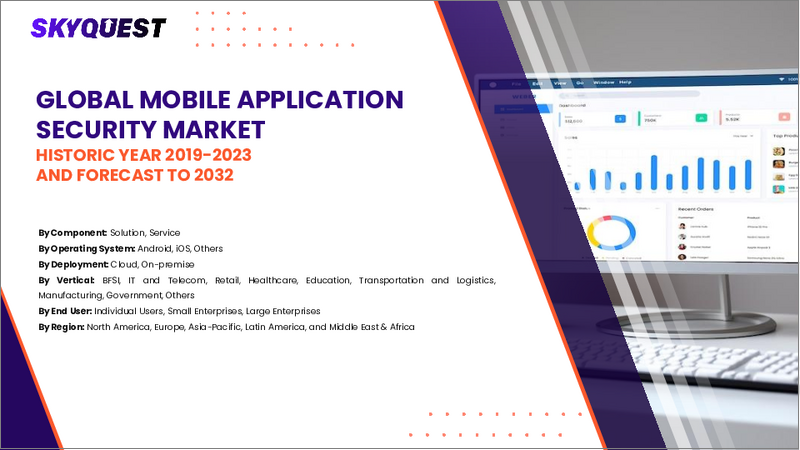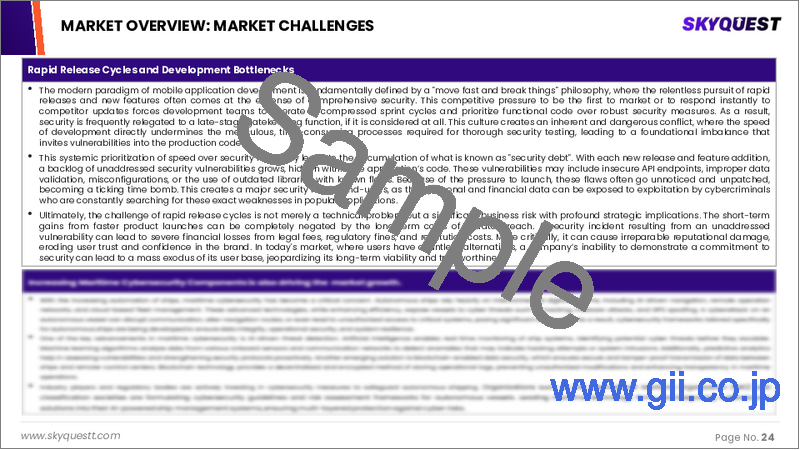|
|
市場調査レポート
商品コード
1658155
モバイルアプリケーションセキュリティ市場規模、シェア、成長分析:ソリューション別、展開別、企業規模別、業種別、地域別 - 産業予測 2025~2032年Mobile Application Security Market Size, Share, and Growth Analysis, By Solution (Software, Services), By Deployment (Cloud, On-premise), By Enterprise Size, By Vertical, By Region - Industry Forecast 2025-2032 |
||||||
|
|||||||
| モバイルアプリケーションセキュリティ市場規模、シェア、成長分析:ソリューション別、展開別、企業規模別、業種別、地域別 - 産業予測 2025~2032年 |
|
出版日: 2025年02月15日
発行: SkyQuest
ページ情報: 英文 197 Pages
納期: 3~5営業日
|
全表示
- 概要
- 目次
モバイルアプリケーションセキュリティ市場規模は2023年に26億米ドルとなり、2024年の32億3,000万米ドルから2032年には184億2,000万米ドルに成長し、予測期間(2025-2032年)のCAGRは24.3%で成長する見通しです。
モバイルアプリケーションセキュリティ市場は、その携帯性と多機能性により、従来のコンピュータよりもスマートフォンやタブレットの人気が高まっていることを背景に、大きな成長を遂げています。モバイルデバイスはメッセージング、メディア消費、オンライン取引に欠かせないものとなる一方で、マルウェア攻撃の増加によってセキュリティリスクも高まっています。BYOD(Bring Your Own Device:私物端末の持ち込み)ポリシーへの移行はこのリスクを増大させるため、強固なセキュリティソリューションが必要となります。高い導入コストやセキュリティ意識の欠如といった課題にもかかわらず、市場は脅威検知と脆弱性管理を強化する人工知能と機械学習の進歩から恩恵を受けています。さらに、デジタル取引を推進する政府の取り組みにより、セキュリティに対する需要がさらに高まっており、市場は今後数年間で大幅な成長を遂げる見通しです。
目次
イントロダクション
- 調査の目的
- 調査範囲
- 定義
調査手法
- 情報調達
- 二次と一次データの方法
- 市場規模予測
- 市場の前提条件と制限
エグゼクティブサマリー
- 世界市場の見通し
- 供給と需要の動向分析
- セグメント別機会分析
市場力学と見通し
- 市場概要
- 市場規模
- 市場力学
- 促進要因と機会
- 抑制要因と課題
- ポーターの分析
主な市場の考察
- 重要成功要因
- 競合の程度
- 主な投資機会
- 市場エコシステム
- 市場の魅力指数(2024年)
- PESTEL分析
- マクロ経済指標
- バリューチェーン分析
- 価格分析
- ケーススタディ
- 特許分析
- 技術分析
モバイルアプリケーションセキュリティ市場規模:ソリューション別& CAGR(2025-2032)
- 市場概要
- ソフトウェア
- サービス
- マネージドサービス
- プロフェッショナルサービス
- コンサルティング
- 統合
- サポートとメンテナンス
モバイルアプリケーションセキュリティ市場規模:展開別& CAGR(2025-2032)
- 市場概要
- クラウド
- オンプレミス
モバイルアプリケーションセキュリティ市場規模:企業規模別& CAGR(2025-2032)
- 市場概要
- 中小企業
- 大企業
モバイルアプリケーションセキュリティ市場規模:業界別& CAGR(2025-2032)
- 市場概要
- BFSI
- 通信・IT
- 小売り
- ヘルスケア
- 教育
- 運輸・物流
- 製造業
- 政府
- その他
モバイルアプリケーションセキュリティ市場規模:地域別& CAGR(2025-2032)
- 北米
- 米国
- カナダ
- 欧州
- ドイツ
- スペイン
- フランス
- 英国
- イタリア
- その他欧州地域
- アジア太平洋地域
- 中国
- インド
- 日本
- 韓国
- その他アジア太平洋地域
- ラテンアメリカ
- ブラジル
- その他ラテンアメリカ地域
- 中東・アフリカ
- GCC諸国
- 南アフリカ
- その他中東・アフリカ
競合情報
- 上位5社の比較
- 主要企業の市場ポジショニング(2024年)
- 主な市場企業が採用した戦略
- 最近の市場動向
- 企業の市場シェア分析(2024年)
- 主要企業の企業プロファイル
- 企業の詳細
- 製品ポートフォリオ分析
- 企業のセグメント別シェア分析
- 収益の前年比比較(2022-2024)
主要企業プロファイル
- IBM(US)
- Synopsys(US)
- Rapid7(US)
- Appdome(US)
- OneSpan(US)
- NowSecure(US)
- Lookout(US)
- Pradeo(France)
- Promon(Norway)
- GuardSquare(Belgium)
結論と提言
Mobile Application Security Market size was valued at USD 2.6 billion in 2023 and is poised to grow from USD 3.23 billion in 2024 to USD 18.42 billion by 2032, growing at a CAGR of 24.3% during the forecast period (2025-2032).
The Mobile Application Security Market is experiencing significant growth, driven by the rising popularity of smartphones and tablets over traditional computers due to their portability and multifunctional capabilities. As mobile devices become essential for messaging, media consumption, and online transactions, they also present increased security risks, highlighted by growing incidences of malware attacks. The shift towards Bring Your Own Device (BYOD) policies amplifies this risk, necessitating robust security solutions. Despite challenges such as high implementation costs and a lack of security awareness, the market is benefiting from advancements in artificial intelligence and machine learning, which enhance threat detection and vulnerability management. Moreover, government initiatives promoting digital transactions create further demand for security, positioning the market for substantial growth in the coming years.
Top-down and bottom-up approaches were used to estimate and validate the size of the Mobile Application Security market and to estimate the size of various other dependent submarkets. The research methodology used to estimate the market size includes the following details: The key players in the market were identified through secondary research, and their market shares in the respective regions were determined through primary and secondary research. This entire procedure includes the study of the annual and financial reports of the top market players and extensive interviews for key insights from industry leaders such as CEOs, VPs, directors, and marketing executives. All percentage shares split, and breakdowns were determined using secondary sources and verified through Primary sources. All possible parameters that affect the markets covered in this research study have been accounted for, viewed in extensive detail, verified through primary research, and analyzed to get the final quantitative and qualitative data.
Mobile Application Security Market Segments Analysis
Global Mobile Application Security Market is segmented by Solution, Deployment, Enterprise Size, Vertical and region. Based on Solution, the market is segmented into Software and Services. Based on Deployment, the market is segmented into Cloud and On-premise. Based on Enterprise Size, the market is segmented into Small and medium-sized enterprises and Large enterprises. Based on Vertical, the market is segmented into BFSI, Telecom and IT, Retail, Healthcare, Education, Transportation and Logistics, Manufacturing, Government and Others. Based on region, the market is segmented into North America, Europe, Asia Pacific, Latin America and Middle East & Africa.
Driver of the Mobile Application Security Market
The mobile application security market is facing obstacles primarily due to the difficulties encountered by small and medium enterprises (SMEs), which are largely tied to limited resources and financial constraints. Many SMEs do not have the required expertise or means to deploy effective security and vulnerability management tools on their mobile devices, leaving their applications vulnerable to various security threats. These financial limitations further complicate their ability to invest in comprehensive mobile application security solutions. Consequently, the relatively low uptake of security measures among SMEs slows the overall growth of the mobile application security market, creating a significant impact on its expansion potential.
Restraints in the Mobile Application Security Market
The mobile application security market faces significant challenges due to the limitations experienced by small and medium enterprises (SMEs), which primarily stem from restricted resources and financial constraints. These SMEs often struggle to acquire the essential tools and expertise needed for effective security and vulnerability management on their mobile devices. Consequently, this lack of capacity hinders their ability to protect mobile applications from potential security threats. Additionally, financial challenges further complicate efforts to invest in robust mobile application security solutions. As a result, the limited adoption of these security measures among SMEs poses a substantial barrier to overall market growth.
Market Trends of the Mobile Application Security Market
The Mobile Application Security market is witnessing a robust trend driven by the escalating dependency on mobile apps across industries. As businesses and consumers alike embrace mobile technology for transactions, communications, and personal information management, the demand for comprehensive security solutions is surging. Organizations are prioritizing mobile application security to safeguard sensitive data against cyber threats, enhance compliance with regulations, and maintain user confidence. Innovations such as AI-driven security measures, threat analytics, and automated vulnerability assessments are becoming standard, reflecting a proactive approach to mitigating risks. This market trend underscores a critical shift towards prioritizing security in the mobile-first landscape of the digital economy.
Table of Contents
Introduction
- Objectives of the Study
- Scope of the Report
- Definitions
Research Methodology
- Information Procurement
- Secondary & Primary Data Methods
- Market Size Estimation
- Market Assumptions & Limitations
Executive Summary
- Global Market Outlook
- Supply & Demand Trend Analysis
- Segmental Opportunity Analysis
Market Dynamics & Outlook
- Market Overview
- Market Size
- Market Dynamics
- Drivers & Opportunities
- Restraints & Challenges
- Porters Analysis
- Competitive rivalry
- Threat of substitute
- Bargaining power of buyers
- Threat of new entrants
- Bargaining power of suppliers
Key Market Insights
- Key Success Factors
- Degree of Competition
- Top Investment Pockets
- Market Ecosystem
- Market Attractiveness Index, 2024
- PESTEL Analysis
- Macro-Economic Indicators
- Value Chain Analysis
- Pricing Analysis
- Case Studies
- Patent Analysis
- Technology Analysis
Global Mobile Application Security Market Size by Solution & CAGR (2025-2032)
- Market Overview
- Software
- Services
- Managed Services
- Professional Services
- Consulting
- Integration
- Support and Maintenance
Global Mobile Application Security Market Size by Deployment & CAGR (2025-2032)
- Market Overview
- Cloud
- On-premise
Global Mobile Application Security Market Size by Enterprise Size & CAGR (2025-2032)
- Market Overview
- Small and medium-sized enterprises
- Large enterprises
Global Mobile Application Security Market Size by Vertical & CAGR (2025-2032)
- Market Overview
- BFSI
- Telecom and IT
- Retail
- Healthcare
- Education
- Transportation and Logistics
- Manufacturing
- Government
- Others
Global Mobile Application Security Market Size & CAGR (2025-2032)
- North America (Solution, Deployment, Enterprise Size, Vertical)
- US
- Canada
- Europe (Solution, Deployment, Enterprise Size, Vertical)
- Germany
- Spain
- France
- UK
- Italy
- Rest of Europe
- Asia Pacific (Solution, Deployment, Enterprise Size, Vertical)
- China
- India
- Japan
- South Korea
- Rest of Asia-Pacific
- Latin America (Solution, Deployment, Enterprise Size, Vertical)
- Brazil
- Rest of Latin America
- Middle East & Africa (Solution, Deployment, Enterprise Size, Vertical)
- GCC Countries
- South Africa
- Rest of Middle East & Africa
Competitive Intelligence
- Top 5 Player Comparison
- Market Positioning of Key Players, 2024
- Strategies Adopted by Key Market Players
- Recent Developments in the Market
- Company Market Share Analysis, 2024
- Company Profiles of All Key Players
- Company Details
- Product Portfolio Analysis
- Company's Segmental Share Analysis
- Revenue Y-O-Y Comparison (2022-2024)
Key Company Profiles
- IBM (US)
- Company Overview
- Business Segment Overview
- Financial Updates
- Key Developments
- Synopsys (US)
- Company Overview
- Business Segment Overview
- Financial Updates
- Key Developments
- Rapid7 (US)
- Company Overview
- Business Segment Overview
- Financial Updates
- Key Developments
- Appdome (US)
- Company Overview
- Business Segment Overview
- Financial Updates
- Key Developments
- OneSpan (US)
- Company Overview
- Business Segment Overview
- Financial Updates
- Key Developments
- NowSecure (US)
- Company Overview
- Business Segment Overview
- Financial Updates
- Key Developments
- Lookout (US)
- Company Overview
- Business Segment Overview
- Financial Updates
- Key Developments
- Pradeo (France)
- Company Overview
- Business Segment Overview
- Financial Updates
- Key Developments
- Promon (Norway)
- Company Overview
- Business Segment Overview
- Financial Updates
- Key Developments
- GuardSquare (Belgium)
- Company Overview
- Business Segment Overview
- Financial Updates
- Key Developments





